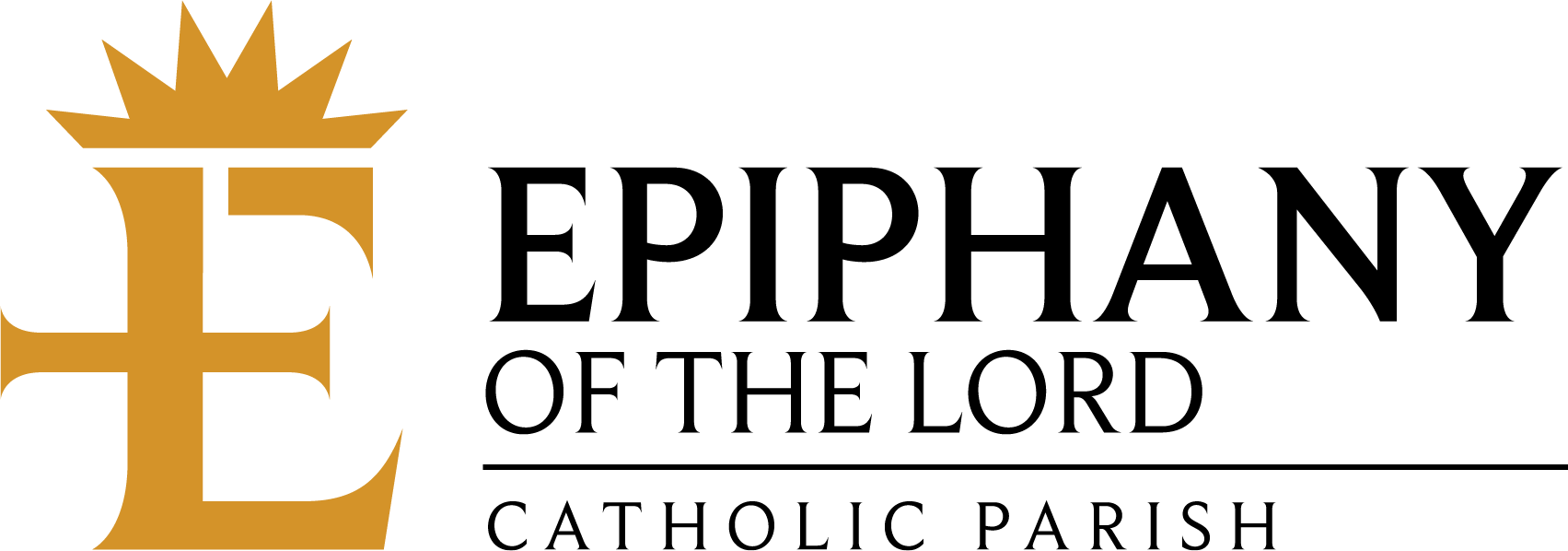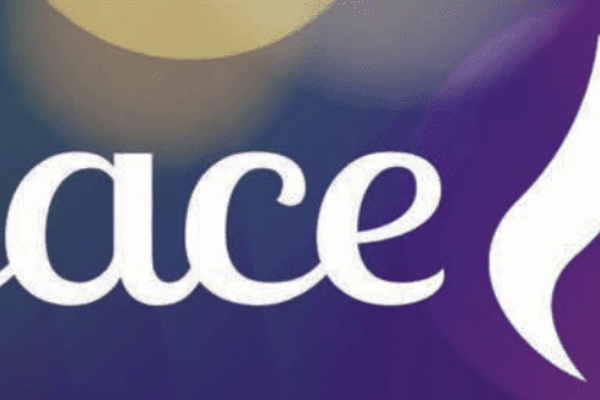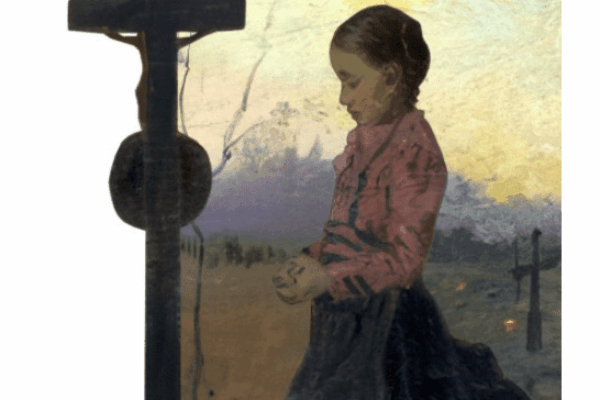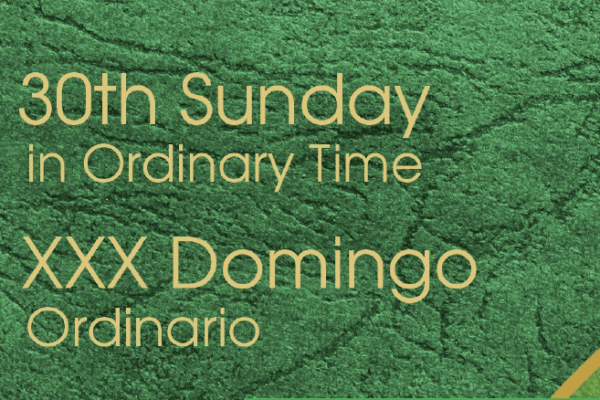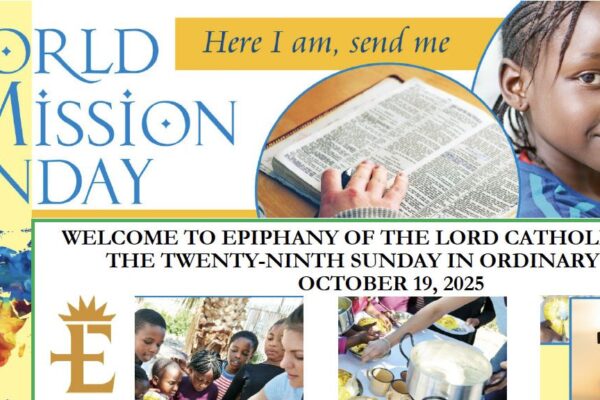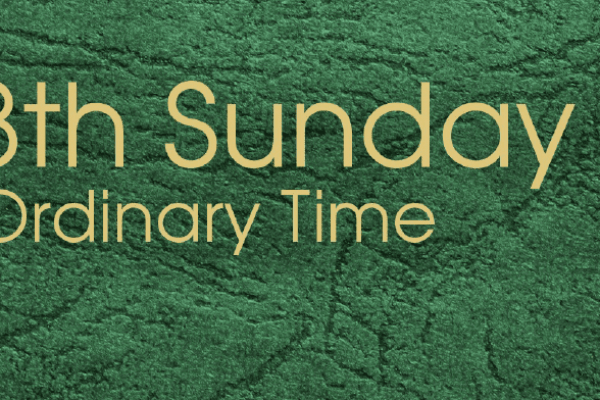4th Sunday of Advent
To The Advent Epiphany Community
The Angel’s Candle (Love Candle): Peace on Earth, Good Will to Men, (Luke 2:13-14)
(Fourth Sunday of Advent, Year A, Mathew 1: 18-24, 21 December 2025)
In Mary’s Yes and Joseph’s Trust: God Draws Near Enough to Make Our Humanity His home The liturgy for today, the Fourth and last Sunday of Advent, is characterized by the theme of closeness, God’s closeness to humanity. The Gospel passage (Mathew 1:18-24) shows us two people, who more than anyone else, were involved in this mystery of love: the Virgin Mary and her husband, Joseph. A mystery of love, the mystery of God’s closeness to humanity. These two figures, Mary and Joseph, who were the first to welcome Jesus through faith, introduce us to the mystery of Christmas. Mary helps us to assume an attitude of openness in order to welcome the Son of God into our concrete life, in our flesh. Joseph spurs us to always seek God’s will and to follow it with full trust. Both allow God to draw near to them. (Pope Francis, Angelus, 2016)
Dearly Beloved Brothers and Sisters, As we gather on this final Sunday of Advent, the Church invites us to stand at the threshold of a mystery: God draws near—quietly, gently, unmistakably.
Today’s liturgy reveals that divine closeness is not an abstract idea but a love that takes flesh in the simplicity of Mary and the fidelity of Joseph. Their openness allows God to step into human history, and their courage teaches us how to welcome God into our own fragile stories. In their yes, heaven leans toward earth, reminding us that God’s nearness is always tender, always transformative. As Christmas dawns, we too are invited to let God come close—into our homes, our wounds, our waiting—so that His presence may reshape our lives from within.
Many years ago, in a small mountain village, there lived an elderly woman named Sofia. Her home was simple, her resources few, but she was known for one thing: whenever someone knocked at her door—be it a neighbor, a traveler, or even a stray dog—she would pause, smile, and say softly: Let me see how God wishes to come close today.
One bitter winter evening, as snow swallowed the path and wind rattled the shutters, there came a hesitant knock. Sofia opened the door to find a young couple, exhausted from travel. The wife was visibly pregnant, the husband anxious, apologetic, unsure whether they should even have approached a stranger’s home. But before they could speak, Sofia stepped aside and said the only words she ever needed in moments like this: Come in. If God comes close, I must make room.
She offered them warm soup, a chair by the fire, and a space to rest. Later that night, as she watched the couple sleeping peacefully, she felt in her heart that she had touched something sacred—not because of what they needed, but because of what they allowed her to receive: the nearness of God hidden in ordinary humanity.
Years afterward, whenever people asked her why she welcomed every knock, Sofia would simply smile and say: Because Mary taught me to open my heart, and Joseph taught me to trust that God’s requests—though small or unexpected—always bring grace. How this anecdote Illuminates the Gospel? Just as Sofia recognized holiness hidden in the ordinary, so Mary and Joseph recognized God drawing near in the fragile circumstances of their lives. Mary opened herself with courageous surrender; Joseph trusted the quiet guidance of God. Together, they welcomed the nearness of the divine in their very flesh, very home, very journey. This anecdote conveys the Advent truth: God’s closeness does not arrive with fanfare, but with a gentle knock, waiting for a heart willing to say: Come in.
A Mystery of Love Unfolding in Ordinary Life-The Gospel of Matthew does not present the Incarnation as a spectacle of power, but as a drama unfolding in the hidden spaces of human life: a betrothed couple, an unexpected pregnancy, a troubled conscience, a dream in the night. God does not erupt into the world through thunder, but whispers through the fears, questions, and hopes of two humble people.
This is the first philosophical lesson of Christmas: God’s greatest interventions do not shatter human freedom but invite it. He waits not with force, but with love—knocking gently, desiring to be welcomed.
In Mary, we see the openness of the human heart at its purest. In Joseph, we see the courage of obedience that trusts without seeing. In both, we discover that the mystery of God’s closeness is not abstract but deeply relational.
Mary: The Space Where God Finds Welcome-Mary teaches us that God’s closeness is received in openness. She does not understand everything. She is not sheltered from fear or bewilderment. Yet her heart remains wide, spacious, available. Let it be done unto me, she says. With that yes—the simplest and most revolutionary word on human lips—humanity welcomes God into its very flesh.
Spiritually, Mary reminds us that God seeks not perfection but hospitality. He desires hearts that are uncluttered, receptive, willing to let grace reshape what we think possible. Pastorally, this is where the homily touches our daily life: Can we allow God to come close in our fatigue? In the tensions of family life? In our mourning, our confusion, our responsibilities? Mary teaches us to say: Lord, enter even here.” Not only where we are strong, but especially where we are fragile.
Joseph: The Quiet Courage of Trust-Joseph, too, stands before us today as a model of profound spiritual maturity. He is a man caught between law and love, between what he understands and what he hopes. And yet, in the gentle silence of the night, he allows God to redirect his plans. Joseph’s greatness lies not in speaking but in listening; not in controlling but in entrusting. He allows God to draw near even when that nearness disrupts his expectations.
This is a philosophical paradox: God’s closeness both consoles and unsettles. It comforts us, yet simultaneously calls us beyond ourselves. Joseph embodies that Advent posture of holy surrender, where faith becomes a quiet, steady yes to a God who writes straight with crooked lines.
God Draws Near to Us Today-The Gospel invites us to see that the Incarnation is not simply an event of the past, but a pattern of the present. God still draws near—in the silence of prayer, in the sacramental life of the Church, in the poor who wait at our doorstep, in the relationships that require forgiveness, in the daily journeys that reshape us bit by bit. Advent reminds us that God’s nearness is not a theory but an experience—one that transforms us when we dare to welcome Him as Mary and Joseph did.
A Pastoral Invitation: Make Room-As Christmas approaches, the question before us is not, Is God close? —for He is. The real question is: Will we allow His closeness to change us? Will we let Mary teach us openness? Will we let Joseph teach us trust? Will we create a space—however small, however hidden—where God may be born anew? Because the mystery of Christmas is not simply that Jesus came into the world, but that He desires to come into your world—your home, your concerns, your hopes. God’s love does not wait for ideal conditions; it enters the messy, complicated spaces of human life, just as it did in Nazareth.
Cumulative Summary: The Closeness of God in Advent-The Fourth Sunday of Advent invites us to contemplate the profound truth that God is near, drawing close to humanity not with power or spectacle, but with tenderness and humility. In the Gospel of Matthew, Mary and Joseph become the first guardians and witnesses of this divine closeness. Their lives reveal that the Incarnation is not only a historical event but a continuing pattern of how God enters human existence. Mary teaches us the spirituality of openness. Her yes is not spoken from certainty but from trust; she welcomes God into her very flesh, showing that divine grace seeks hearts that are receptive rather than perfect. Through her, we learn that God desires to enter even the fragile and complicated spaces of our lives. Joseph teaches us the spirituality of trust. Faced with confusion, he listens for God’s voice in silence and allows his expectations to be reshaped. His quiet obedience reveals that God’s nearness often unsettles before it comforts; it calls us beyond ourselves into deeper faith. Together, Mary and Joseph show that God’s closeness is relational: it requires human cooperation, hospitality of heart, and the courage to surrender our plans to His. Their witness becomes a mirror for our own journey: God still draws near—through prayer, through the sacraments, through those in need, through the ordinary rhythms of daily life.
As Christmas approaches, the invitation is simple yet demanding: Make room. Welcome God’s closeness with the openness of Mary, the trust of Joseph, and the awareness that divine grace seeks to be born in us today. The mystery of Christmas is that God does not wait for perfect conditions—He enters the very places where we live, struggle, hope, and love.
Dear Epiphany, on this Fourth and final Sunday of Advent, the liturgy draws our attention to one profound and tender truth: God is close. Not distant, not indifferent, not observing us from afar, but drawing near—near enough to touch our humanity, to enter our stories, to dwell in our flesh. Advent, in its deepest sense, is the season of divine proximity. And in today’s Gospel, two quiet figures illuminate this mystery with extraordinary clarity: Mary and Joseph. As we stand at the threshold of Christmas, Mary and Joseph lead us gently into the heart of the mystery: God is close—closer than we dare to imagine, closer than our fears, closer than our sins, closer than our breath. Let us welcome Him with the courage of Joseph and the openness of Mary, that our lives too may become places where the Word becomes flesh.
Fraternally,
Fr. John Peter Lazaar SAC, Pastor
3rd Sunday of Advent
To The Advent Epiphany Community The Shepherd’s Candle (The Candle of Joy): Joy at the Soon-Coming of Jesus (Luke 2:10–12) (Third Sunday of Advent: Gaudete Sunday, Matthew 11:2-11, 14 December…
2nd Sunday of Advent
To The Pilgrims of Hope at Epiphany The Bethlehem (Peace) Candle: Mary and Joseph’s Journey from Nazareth to Bethlehem (Luke 2:4-7)(Second Sunday of Advent, Year A, Mathew 3:1-12, 07 December…
First Sunday of Advent: A Season of Hopeful Vigilance
(Isaiah 2:1–5, Romans 13:11–14, Matthew 24:37–44) Dear Parish Family, Today the Church begins a new liturgical year—a fresh journey of faith for the People of God. As always, we set…
Thirty-Third Sunday in Ordinary Time
Thirty Third Sunday ( Malachi 3:19–20A; 2 Thessalonians 3:7–12; Luke 21:5–19) Dear Parish Family, The word Parousia in Greek means “presence” or “coming,” and in Christian theology it refers to…
All Souls Day Homily
Readings: Wisdom 3:1–9; Psalm 23; Romans 5:5–11; John 6:37–40 My dear brothers and sisters in Christ, As we gather today for All Souls Day, we fondly remember our loved ones…
All Souls Day
(Wisdom 3:1–9; Psalm 23:1–6; Romans 5:5–11; John 6:37–40) Dear Parish Family, This weekend, as we gather for the Commemoration of All the Faithful Departed — All Souls Day — we…
30th Sunday in Ordinary Time
To The Epiphany Community Prayer Becomes Authentic: When the Heart Turns from the Mirror of Self to the Mercy of God (30 Week in Ordinary Time, Luke 18:9-14, 26 October…
29th Sunday in Ordinary Time
To The Epiphany Community Mission is the Outward Journey of Grace: Sustained by the Inward Ascent of Prayer (29 Week in Ordinary Time, Luke 18:1-8, 19 October 2025) The World…
28th Sunday in Ordinary Time
The Healed Body Returns to Dust: But the Grateful Heart Lives Forever (28 Week in Ordinary Time, Luke 17:11-19, 12 October 2025) This Sunday’s Gospel presents Jesus healing 10 lepers,…
